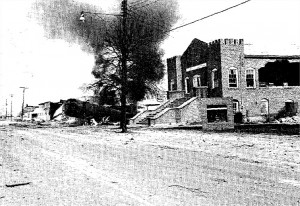A freight train with 4 diesel-electric locomotives and 139 cars and caboose derailed at 04:15 a.m. when passing a crossing at 48 km/h. The west wheel on the lead truck of the 62nd car in the train broke ; the tank car n°62 and 14 other tank cars loaded with liquefied petroleum (LPG) behind it derailed after 654 m. Most of the tanks involved were damaged, resulting in a immediate violent eruption of fire and explosion. The first explosion awakened many of the residents in the community and started fires near the tracks. People evacuated in a 600 m radius and traffic was stopped. For about 40 min, continued explosions (BLEVE’s) set fire to dwellings and cars rocketing did extensive damage. Meanwhile, train crewmembers pulled away the cars still on the tracks. Local fire-fighters, supported by the red cross and 200 volunteers organised the evacuation and prevented the fires from spreading. The fire was brought under control the next day by noon after an intervention of the US Army (they vented the 2 remaining tank cars using shaped explosive charges !) ; people were allowed to return the area and the track was reopened for low speed service at 5:30 pm.
In total, 54 residences were substantially destroyed and over 1,350 buildings were damaged, including 6 schools and 5 churches. Two persons died, 33 were hospitalised and 900 treated at aid stations and clinics. The damage amounted to 3 M dollars, of which 0,38 M dollars to track and equipment.
The broken wheel had been manufactured and in service since 1962. The break was a brittle fracture which originated in the back of the plate in a roughly machined area. The mechanical puncturing of the tanks by a coupler furnished the initial fuel which started the event.
The accident was the beginning of the effort which ultimately (over a 10 years period) resulted in hazardous materials tank cars being equipped with head shields (an extra plate over the end of the tank) to reduce the chance of a coupler puncturing the pressure head) and possibly bottom shelf couplers.




